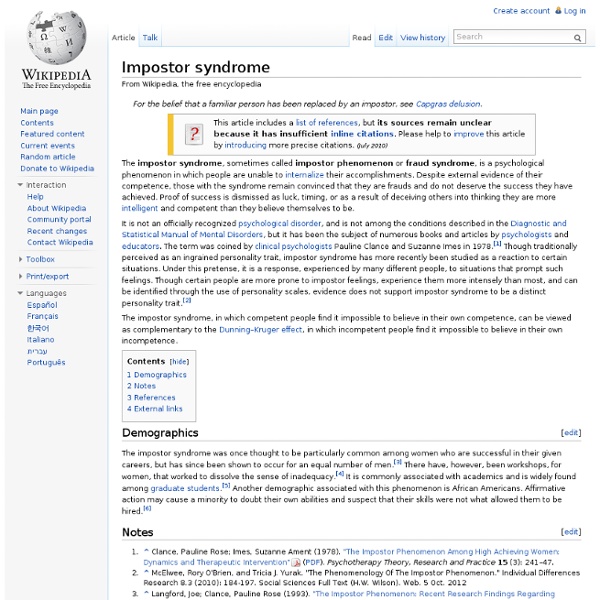DarkCopy - Simple, full screen text editing - StumbleUpon
Introduction à la psychologie sociale, du travail et des organisations/La communication
Une page de Wikiversité. Début de la boite de navigation du chapitre fin de la boite de navigation du chapitre En raison de limitations techniques, la typographie souhaitable du titre, « Introduction à la psychologie sociale, du travail et des organisations : La communicationIntroduction à la psychologie sociale, du travail et des organisations/La communication », n'a pu être restituée correctement ci-dessus. Dans ce chapitre, nous allons aborder la notion de communication au sein des groupes restreints. Définition[modifier | modifier le wikicode] La communication c'est l'action de communiquer, c'est-à-dire, d'établir une relation avec autrui, de transmettre quelque chose à quelqu'un. La communication permet la réalisation d'interactions au sein d'un groupe donné. Bavelas et l'étude des réseaux[modifier | modifier le wikicode] Alexander Bavelas est un psychosociologue américain né en 1920. La rétroaction[modifier | modifier le wikicode] On distingue divers types de groupes organisationnels.
Structural Abstractions in Brains and Graphs
A graph database is a software system that persists and represents data as a collection of vertices (i.e. nodes, dots) connected to one another by a collection of edges (i.e. links, lines). These databases are optimized for executing a type of process known as a graph traversal. At various levels of abstraction, both the structure and function of a graph yield a striking similarity to neural systems such as the human brain. It is posited that as graph systems scale to encompass more heterogenous data, a multi-level structural understanding can help facilitate the study of graphs and the engineering of graph systems. Finally, neuroscience may foster a realization and appreciation of the various structural abstractions that exist within the graph. The Neuron and the Vertex At a primitive level, the structure of the human brain can be described as a network of neurons. In network science, algorithms exist to identify larger structures within the graph. The Area and the Motif Conclusion
9 Sites That Find People and Their 'Sensitive' Information
At one time or another, you might need to get the goods on a stranger, like a prospective nanny or a business contact. Public records and people-finder sites are often the place to look; we list the best ones here. These sites use cool, Web 2.0 techniques to help you locate people, then (if need be) dig deep to find the "sensitive" intel about them you need. WhitePages.com: WhitePages and PeopleFinders are both good tools for tracking down people, their addresses, and their phone numbers, but the nod goes to WhitePages for its upcoming addition of voice and mobile capabilities. FriendFeed: Many content sharing and social networking sites exist now--Facebook, Flickr, Twitter, and so on--and my friends seem to be spread out evenly among them. I don't have time to visit them all. Spock: This site looks for a person's school, work, and social affiliations, then displays photos, links to social network pages, Web sites, videos, and blogs about that person.
ancrer en un temps record
Graphs, Brains, and Gremlin | Marko A. Rodriguez
SMI32-stained pyramidal neurons in the cerebral cortex. Provided by UC Regents Davis under Creative Commons Attribution 2.5 License What do graphs and brains have in common? First, they both share a relatively similar structure: Vertices/neurons are connected to each other by edges/axons. Second, they both share a similar process: traversers/action potentials propagate to effect some computation that is a function of the topology of the structure. If there exists a mapping between two domains, then it is possible to apply the processes of one domain (the brain) to the structure of the other (the graph). The Rosetta Stone of Graphs “The term connectionism is usually applied to neural networks. In the article, Dr. Why are brains interesting for those doing software engineering, data management, and information retrieval? Spreading Activation and the Brain Spreading activation is an algorithm that simulates the real-world process of a cascade of action potentials (neuron depolarizations).
Did You Know Archive & 14 fun facts you probably didn't know
Source Source Source Some other swear slangs were FLOGGING CULLY. TWIDDLE-DIDDLES. TWIDDLE POOP. Source Source Source Source Source Source Source Also known as Sleeping Beauty Syndrome Source Most Popular Posts This Week
Propos de Table
Bibliothèque A Bernard Litzer, Henri Tincq et au Pasteur Simon Weber. Le fichier au format Zip Cette édition est présente sur Google Introduction et dédicace: Deux événement ont conduit à cette numérisation. Le commentaire met en avant une certaine légèreté du Pape Médicis Léon X lorsqu'a été signée cette sentence. L'autre événement et premier en date, qui avait fait émerger l'idée, venait d'un propos du Pasteur Simon Weber, directeur du service de la communication de la FEPS (Fédération des Eglises protestantes de Suisse), paru dans Le Temps. Tout cela est relativement primaire et m'avait rappelé un classique qui ne figurait pas alors sur Google, les fameux et illustres propos de table de Martin Luther.
Everything is a Remix – Historia de la creatividad y la innovación
El arte de crear está rodeado de mitos, el mayor de los cuales es que la creatividad nace de la inspiración: las creaciones originales son producto de genios. Pero la creatividad no es magia: sucede aplicando herramientas y pensamientos comunes a materiales existentes. Concretamente: aprendemos copiando, imitando, emulando. Para empezar, no podemos crear algo antes de controlar a la perfección las herramientas importantes en el ámbito en que trabajamos. Una vez hemos adquirido los pilares fundamentales a través de la copia, llega el siguiente paso: transformar. La primera parte del documental muestra esta experiencia en el sector de la música, en concreto a través del caso de Led Zeppelin. Pero las creaciones más importantes llegan normalmente en una tercera fase: la combinación. El documental presenta los conceptos básicos de toda creación –copia, transformación, combinación- a través de numerosos casos bien conocidos: Y, como no, el célebre caso de Xerox.



